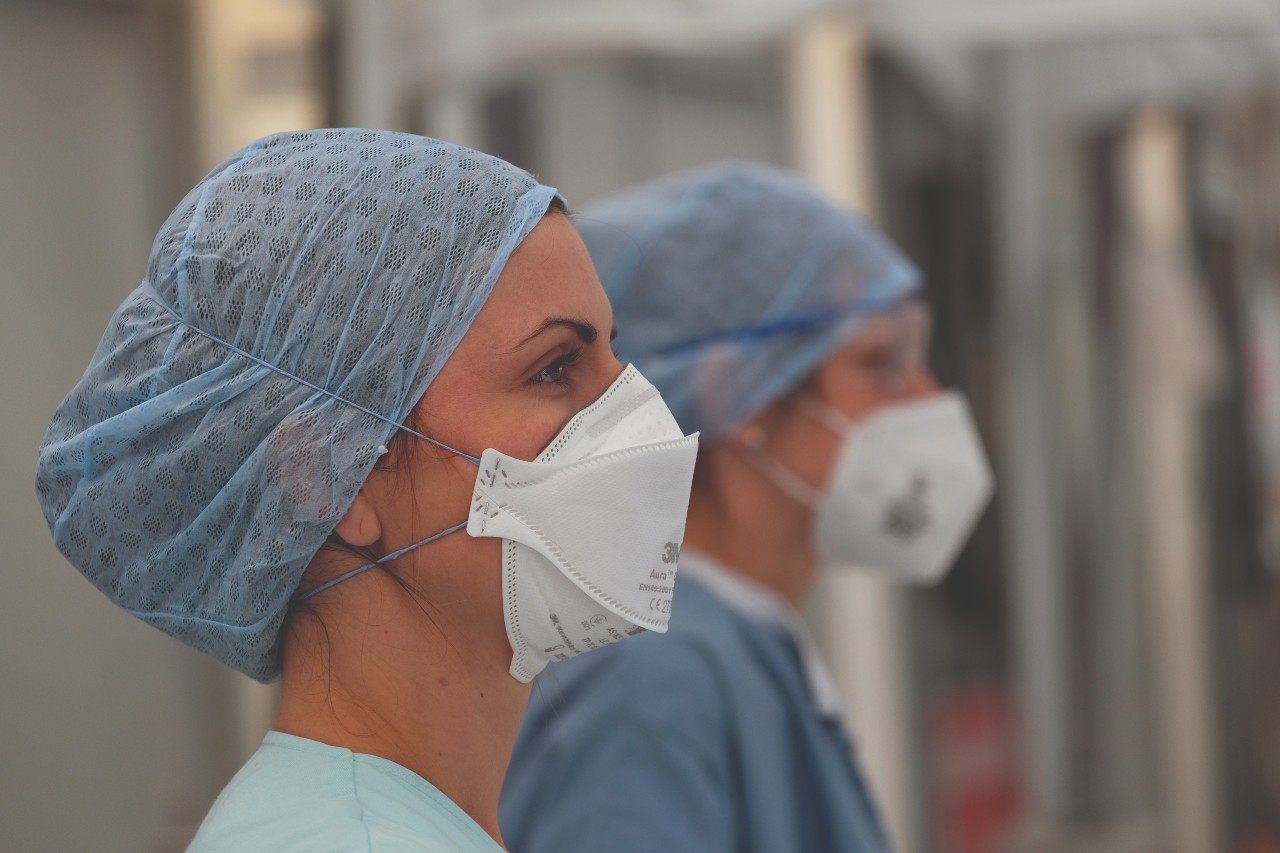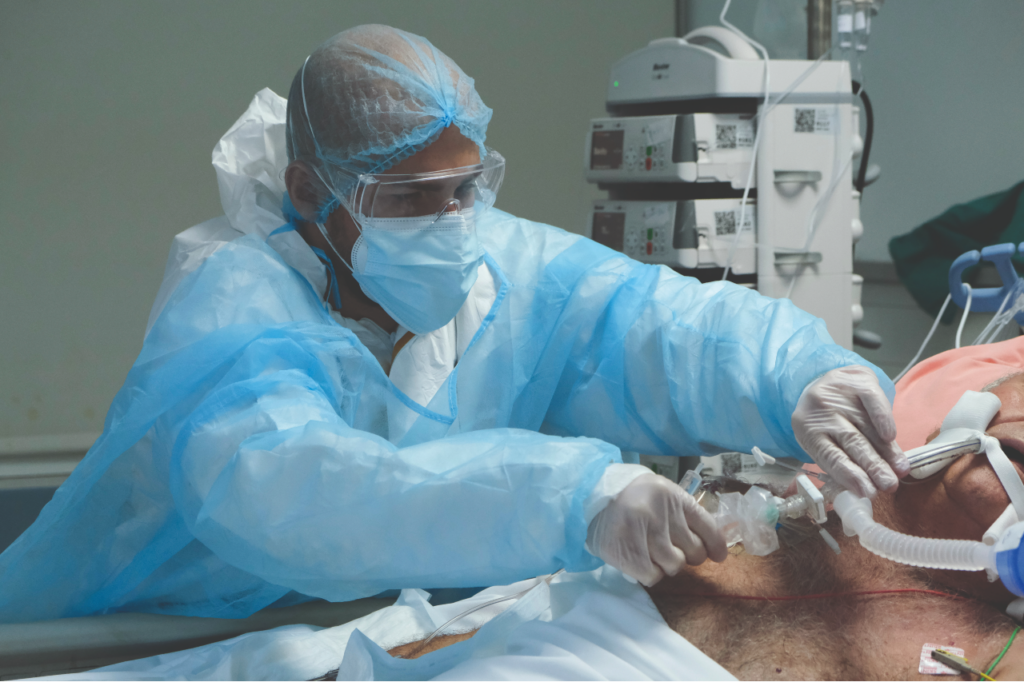While the focus during the pandemic tended to fall on ICU equipment, the utilisation of ICU staff may leave a long shadow on the profession. But how deep and long-lasting could the impact be?

ICU staff in Liège, Belgium prepare themselves for another onslaught in caring for Covid-19 sufferers. (Photo by Alexandros Michailidis/Shutterstock)
The equipment is the easy part. Beds are an important measure, but ICUs wouldn’t be needed at all if frames and mattresses alone saved lives. Unlike the people working around them, they don’t keep the system from toppling, nor will their shelter count for much if it does. Unfortunately, minds can’t be laundered like sheets. Sarah Graham asks Tim Cook, consultant in anaesthesia and intensive care medicine at Royal United Hospitals in Bath, UK, and Greg Martin, president of the US Society of Critical Care Medicine, about the impact of the pandemic on ICU staff.
As the name suggests, work in intensive care has never been a walk in the park. Caring for the most critically ill patients requires specialist skill and one-to-one attention, as well as the sensitivity to manage relationships with their families. But, for ICUs around the globe, the last year or so has been significantly more intensive than most.
These wards have become a focal point of the Covid-19 pandemic and a barometer for how well healthcare systems are coping. And while many column inches have been devoted to counting bed spaces, ventilators and PPE, critical care’s most valuable resources – its people – have been courageously getting on with whatever needs to be done.
At the various peaks of the pandemic, ICUs have been likened to battlefields. But doctors and nurses are not soldiers, and nor did they sign up to fight in a war. After more than 12 months of putting their lives on the line, staff have been left feeling wrung out. “The bottom line is that people are depleted and exhausted, and they have been harmed by what’s happened,” says Tim Cook, a consultant in anaesthesia and intensive care medicine at Royal United Hospitals in Bath, south-west England.
“The pandemic has really exposed a lot of the underlying issues we have in critical care,” adds Dr Greg Martin, president of the Society of Critical Care Medicine in the US. “Issues around staff stress, workload, burnout and wellness have been just under the surface in critical care for a long time, but Covid has magnified that by a thousand.
“The things we do every day are much more challenging when you put them in an environment where we’re working more, we don’t have certainty about how to care for patients, and we don’t have certainty about how to keep ourselves, our patients and our families safe.”
Particularly during the early months of the pandemic, ICU staff were dealing not only with unprecedented and growing demand on their resources, but also with huge unknowns about the disease itself. “There was a tonne of uncertainty about what Covid actually was and what treatments were going to work,” says Martin. “All of that was made worse by the deluge of literature coming out. People couldn’t keep up with the amount of new information, and particularly [with] trying to appraise it: ‘Is this high-quality or low-quality literature? And how does it apply to my patient?’”
In reality, he adds, much of this apprehension proved unfounded. “It really ended up reminding us that almost everything we do every day in other critically ill patients completely applies to Covid-19. That doesn’t mean there aren’t some unique things we need to do differently, but we know how to take care of patients who have pneumonia; we know how to take care of patients who require respiratory support and end up on a mechanical ventilator. The standards we’ve developed over years and decades in critical care were actually incredibly useful.”
Psychological toll on ICU staff
None of that, of course, negates the difficulties of those early months – nor the exhaustion, trauma and moral injury that so many staff are feeling now. “There was real, genuine fear during the first surge, which was compounded by concerns about access to PPE and the fact that quite a few healthcare workers were dying,” says Cook.
A year in, the fear has eased somewhat – but the same cannot be said for workloads, which have remained extremely challenging. In normal times and under normal standards in the UK, there would be one specialist ICU nurse to every patient. At its worst, the pandemic stretched those ratios to three or more patients per specialist nurse, with support from redeployed nurses without specialist intensive care training.

Similar ratios have applied to doctors, physios and other healthcare workers, Cook notes, but the heaviest burden has fallen to nursing staff. And beyond clinical care, he adds, one of the most overlooked challenges has been having to communicate with patients’ families by video or phone.
“A lot of what we do in intensive care is very technical, high-end medical care, often being done to a patient who’s unconscious and attached to machines,” Cook says. Restrictions on visitors have, therefore, been challenging not just for patients and their families, but also for the healthcare professionals caring for them. In normal times, he explains, staff get to know their patients, and make informed, collaborative decisions about care through ongoing bedside conversations with their loved ones. These sensitive and complex discussions are simply not the same when conducted through a phone or video call.
“I don’t think people appreciate how difficult that has been,” he adds. “Staff have experienced enormous psychological distress from seeing a large number of patients who they couldn’t treat, or many patients who have died. These experiences have been very harrowing, and a significant number of staff have been psychologically harmed by working in this environment.”
Resource allocation
It’s in this context, with staff spread so thinly, that Cook talks about the unenviable decisions they have faced around allocating resources and maintaining standards. For him, ICU resources can be considered as four ‘S’s: space, staff, systems and stuff. But, while you can reallocate beds, expand your physical space into disused operating theatres or manufacture new equipment in a crisis, the vital human resources of trained and experienced staff remain finite.
This is aggravated, Martin points out, by existing staff shortfalls, as well as the increased time and complexity involved in caring for Covid patients. At the beginning of the pandemic, before testing became more widely available, many hospitals also had to send large numbers of staff with suspected Covid-19 symptoms home to self-isolate.
“When you put all that together, you can quickly see how you end up with a higher number of patients, more complexity, more time needed to care for each patient and fewer people to do it,” Martin says. “That really adds to the uncertainty of, ‘How do I take care of these patients?’”
With no national guidelines on managing such dilemmas, hospitals on both sides of the Atlantic have grappled with the ethical considerations around how to allocate resources if it came down to deciding between two patients for one bed or ventilator. Under normal circumstances, Cook explains, doctors are able to make choices based on which treatment is in an individual patient’s best interests. Without adequate resources, though, treatment options are more limited, and those decisions become much more difficult. “The fear in March was that the demand from Covid would outstrip resources, and that treatment decisions would have to be made based on an inadequate resource,” he says.
In NHS ICUs, Cook feels these quandaries have, by and large, been avoided – both by reducing demand through national lockdowns and by diverting resources away from other, less urgent medical care. But, while NHS staff have worked hard to deliver care to their usual high standards, he adds, “At times it’s clear that the quality of care delivered has not been the same as normal.”
Morale hazard
These compromises on care, as understandable as they are, add to the already overwhelming toll on staff morale – and Covid’s grip on ICUs is not loosening any time soon. While much of the world looks optimistically to the roll-out of vaccines as a glimmer of light at the end of the tunnel, ICU staff continue battling in the dark.
“I am gaining confidence that we’re getting there. But, for staff working in ICUs, the pandemic is still very much going on,” Martin says. “We still have severely ill Covid patients in our ICUs who are suffering every day, and we still have the challenges of keeping family members away from them because it’s not safe. There’s not necessarily an end to that in sight.”
For Cook, the situation is “less worse” than it has been, but the impact of lockdown measures and the vaccine roll-out will take longer to reach the ICU than the general hospital population because of the complexity and duration of care their patients require.
In the longer term, he adds, the legacy of the pandemic must be a change in the way ICUs operate. “There needs to be a bigger plan that enables us to flex up and have increased overall capability, but also increased surge capability,” he says. This will mean investing in all four of those ‘S’s to better meet the needs of ageing populations and ensure that ICUs are prepared for scaling up in any future crisis.
More immediately though, Cook says staff will need time and support to take the annual leave they’ve missed out on, see their families and recover mentally. Those needs may well find themselves at odds with a drive to resume other services as quickly as possible – but, if it is to be sustainable, getting back to normal will require patience and careful planning.
This article first appeared in Practical Patient Care, issue 27. The full publication can be viewed online here.
